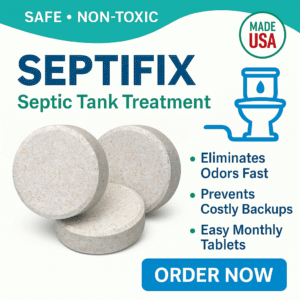If you own an RV and want to stay parked at home or on a long-term site, you might be wondering how to permanently hook up an RV to a septic system. While many RVers get by with temporary hoses and weekly dumps, a permanent hookup makes life easier—no more dragging hoses or moving your rig just to empty tanks. Done correctly, it’s convenient, sanitary, and fully legal. In this guide, we’ll explain the process, the equipment you’ll need, and the best products to make a permanent RV-to-septic connection that lasts.
Quick Picks: Best Equipment for Permanent RV Septic Hookups
- Camco RhinoEXTREME 20-Foot RV Sewer Hose Kit – Best Overall: durable, crush-resistant hose designed for permanent and seasonal setups.
- Polylok 24″ Septic Riser Kit with Lid – Best Budget: brings the septic inlet to grade, making RV connections simple and clean.
- Liberty Pumps Pro380 Sewage Ejector Package – Best Premium: a full basin + pump system for when your RV sits below the tank inlet.
Buyer’s Guide: Key Things to Know Before Connecting
- Local Codes: Some municipalities require permits or specific fittings for permanent RV connections.
- Tank Location: Make sure your septic tank has an accessible inlet or riser near where you’ll park the RV.
- Gravity vs. Pump: If the RV drain is higher than the tank inlet, gravity works. If not, you’ll need a sewage ejector pump.
- Pipe Material: PVC pipe is the best choice for permanent lines—rigid, durable, and less prone to leaks than flexible hose.
- Access for Pumping: Adding a riser makes it easier for pump trucks and also simplifies the RV tie-in.
Step-by-Step: How to Permanently Hook Up Your RV
- Locate the Septic Inlet: Find the cleanout or add a riser kit to your tank inlet.
- Lay Out the Route: Plan the shortest path between the RV outlet and the tank inlet.
- Choose Your Connection: Use rigid PVC pipe for a true permanent hookup, or heavy-duty hose for seasonal setups.
- Seal the Joints: Use proper fittings and rubber gaskets to ensure no leaks or odors.
- Secure and Test: Make sure the line is supported and has proper slope before running a test dump.
- Add a Pump if Needed: If the RV outlet sits lower than the tank inlet, install a sewage ejector pump system.
Detailed Product Reviews
Camco RhinoEXTREME RV Sewer Hose Kit
Who it’s for: RV owners who want a heavy-duty hose that can withstand long-term outdoor use.
- Key Benefits: Crush-resistant design; UV stabilized; comes with swivel fittings.
- Pros: Flexible, affordable, easy to install.
- Cons: Less permanent than rigid PVC lines.
Verdict: A tough, reliable choice for seasonal or semi-permanent setups.
Polylok 24″ Septic Riser Kit
Who it’s for: Homeowners who want easy access to their septic tank for RV tie-ins and pumping.
- Key Benefits: Raises inlet to ground level; watertight lid; simplifies maintenance.
- Pros: Affordable; durable; quick installation.
- Cons: Requires secure installation to avoid shifting.
Verdict: The easiest way to make your septic system RV-ready.
Liberty Pumps Pro380 Sewage Ejector Package
Who it’s for: RV setups where gravity drainage isn’t possible.
- Key Benefits: Pre-assembled basin with pump; handles solids up to 2″; dependable brand.
- Pros: Plug-and-play design; strong build quality; professional performance.
- Cons: Higher cost; requires electrical hookup.
Verdict: A premium but reliable solution for long-term RV living.
Charlotte Pipe 4-Inch PVC Sewer Pipe
Who it’s for: RV owners who want a permanent underground connection.
- Key Benefits: Rigid pipe eliminates leaks; designed for sewer use; long lifespan.
- Pros: Permanent; affordable; widely available.
- Cons: Requires trenching and proper slope.
Verdict: The best option for a true long-term connection.
Comparison Table
| Product | Type | Best For | Price Link |
|---|---|---|---|
| Camco RhinoEXTREME Hose | Flexible Hose | Semi-permanent hookups | See Price |
| Polylok 24″ Riser Kit | Riser + Lid | Easy septic access | See Price |
| Liberty Pumps Pro380 | Sewage Ejector Package | RV setups below tank | See Price |
| Charlotte Pipe PVC | Rigid Pipe | Permanent underground lines | See Price |
FAQ
1. Do I need a permit to connect an RV to my septic tank?
In many counties, yes. Always check local codes before making a permanent connection.
2. Can I just run a hose into my septic tank?
For temporary use, yes. But for permanent setups, rigid PVC pipe is recommended for safety and reliability.
3. What if my RV outlet is lower than the septic inlet?
You’ll need a sewage ejector pump system like the Liberty Pro380.
4. How deep should I bury PVC pipe for RV septic hookup?
Typically 12–18 inches, but check frost depth requirements in your area.
5. Can multiple RVs hook to one septic tank?
Yes, as long as the tank and drain field are sized to handle the load.
Conclusion
Permanently hooking an RV to a septic tank is possible, convenient, and safe when done correctly. Whether you use a heavy-duty hose like the Camco RhinoEXTREME or go all in with rigid PVC pipe, your setup will save time and hassle. If your site sits lower than the tank, a premium system like the Liberty Pumps Pro380 makes the hookup seamless. With the right equipment and a little planning, your RV can enjoy a permanent, worry-free connection to your home septic system.
